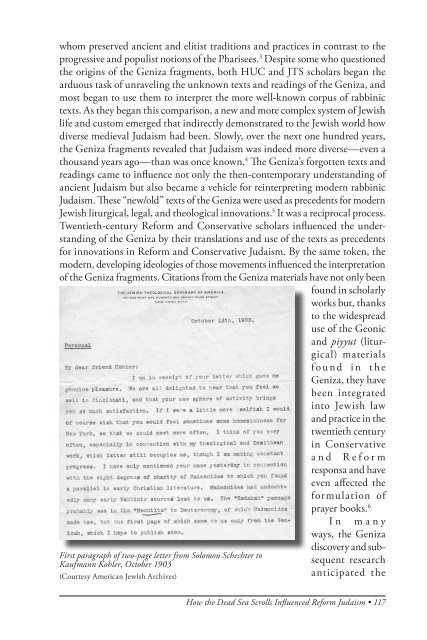The American Jewish Archives Journal, Volume LXI 2009, Number 1
The American Jewish Archives Journal, Volume LXI 2009, Number 1
The American Jewish Archives Journal, Volume LXI 2009, Number 1
You also want an ePaper? Increase the reach of your titles
YUMPU automatically turns print PDFs into web optimized ePapers that Google loves.
whom preserved ancient and elitist traditions and practices in contrast to the<br />
progressive and populist notions of the Pharisees. 3 Despite some who questioned<br />
the origins of the Geniza fragments, both HUC and JTS scholars began the<br />
arduous task of unraveling the unknown texts and readings of the Geniza, and<br />
most began to use them to interpret the more well-known corpus of rabbinic<br />
texts. As they began this comparison, a new and more complex system of <strong>Jewish</strong><br />
life and custom emerged that indirectly demonstrated to the <strong>Jewish</strong> world how<br />
diverse medieval Judaism had been. Slowly, over the next one hundred years,<br />
the Geniza fragments revealed that Judaism was indeed more diverse—even a<br />
thousand years ago—than was once known. 4 <strong>The</strong> Geniza’s forgotten texts and<br />
readings came to influence not only the then-contemporary understanding of<br />
ancient Judaism but also became a vehicle for reinterpreting modern rabbinic<br />
Judaism. <strong>The</strong>se “new/old” texts of the Geniza were used as precedents for modern<br />
<strong>Jewish</strong> liturgical, legal, and theological innovations. 5 It was a reciprocal process.<br />
Twentieth-century Reform and Conservative scholars influenced the understanding<br />
of the Geniza by their translations and use of the texts as precedents<br />
for innovations in Reform and Conservative Judaism. By the same token, the<br />
modern, developing ideologies of those movements influenced the interpretation<br />
of the Geniza fragments. Citations from the Geniza materials have not only been<br />
found in scholarly<br />
works but, thanks<br />
to the widespread<br />
use of the Geonic<br />
and piyyut (liturgical)<br />
materials<br />
f ou nd i n t he<br />
Geniza, they have<br />
been integrated<br />
into <strong>Jewish</strong> law<br />
and practice in the<br />
twentieth century<br />
in Conservative<br />
a n d R e f o r m<br />
responsa and have<br />
even affected the<br />
formulation of<br />
prayer books. 6<br />
First paragraph of two-page letter from Solomon Schechter to<br />
Kaufmann Kohler, October 1903<br />
(Courtesy <strong>American</strong> <strong>Jewish</strong> <strong>Archives</strong>)<br />
I n m a n y<br />
ways, the Geniza<br />
discovery and subsequent<br />
research<br />
anticipated the<br />
How the Dead Sea Scrolls Influenced Reform Judaism • 117

















